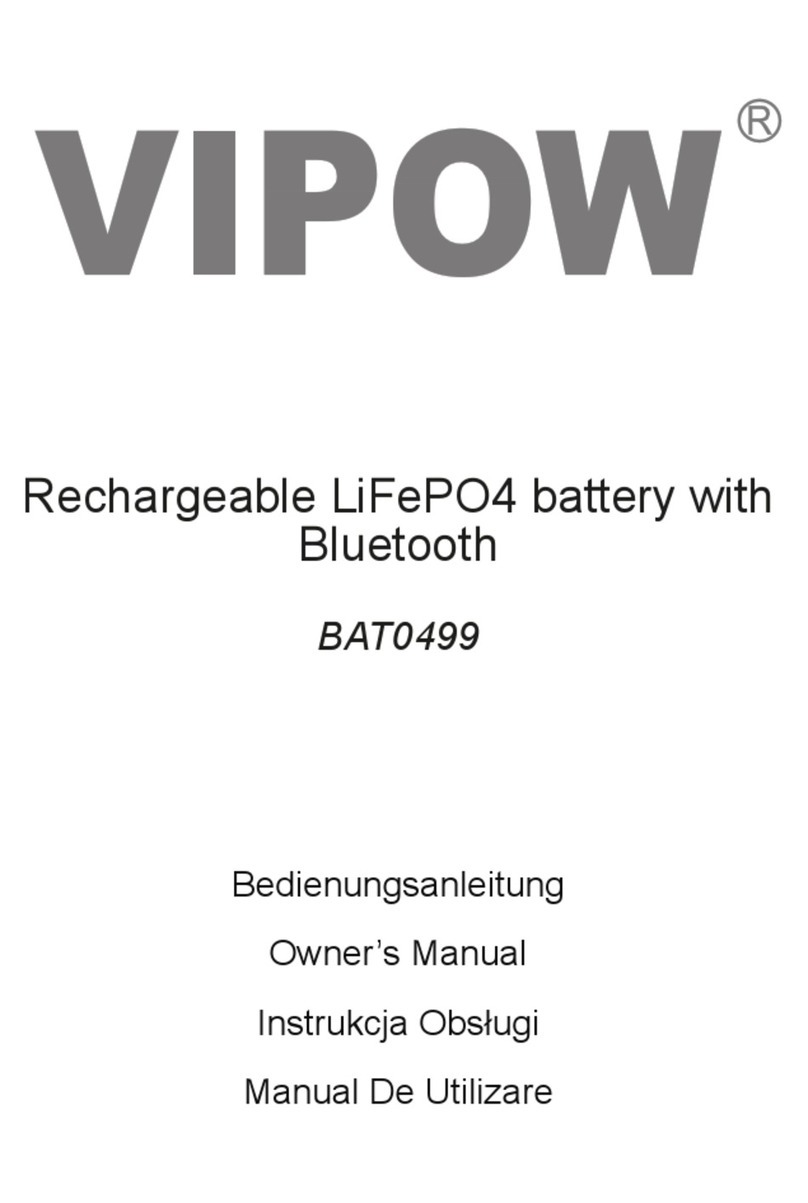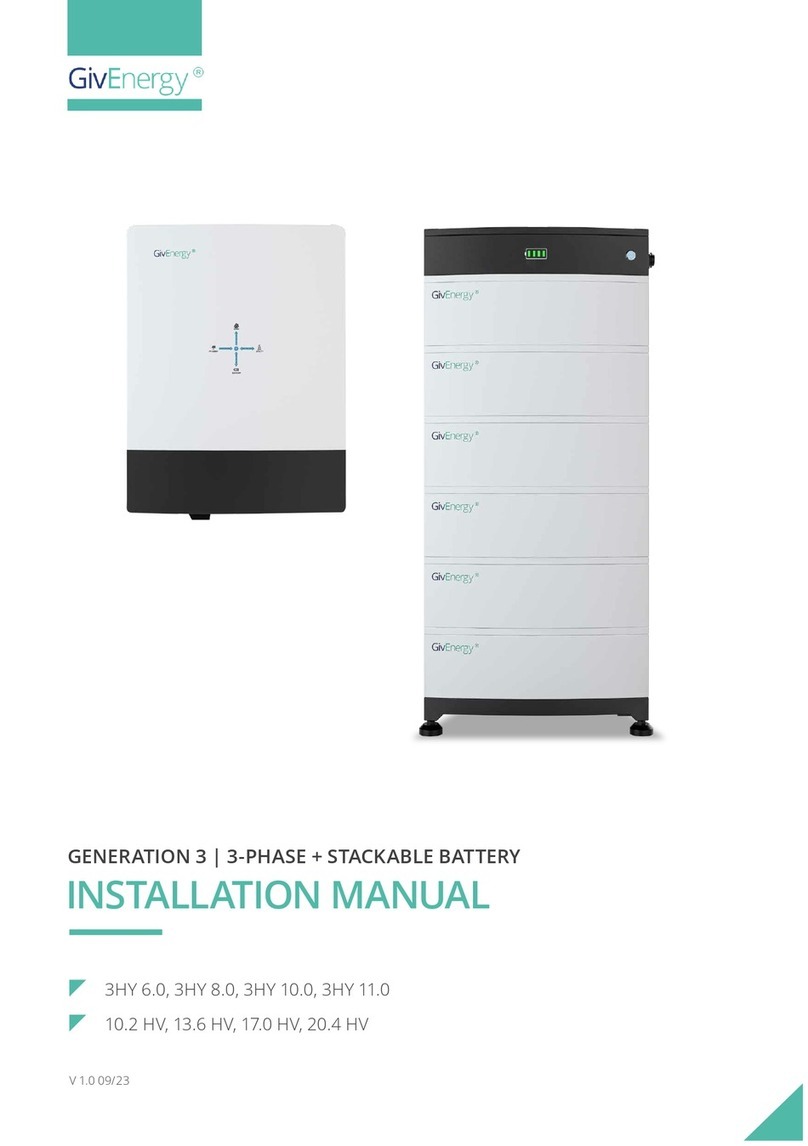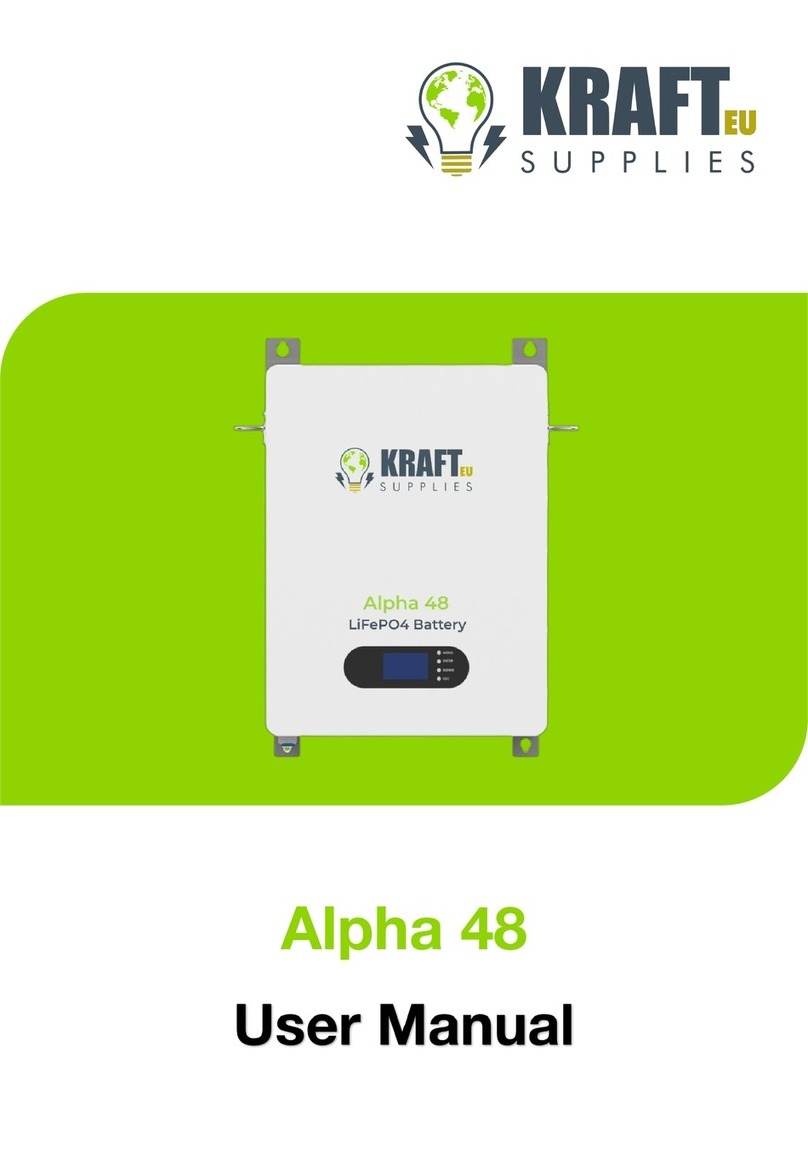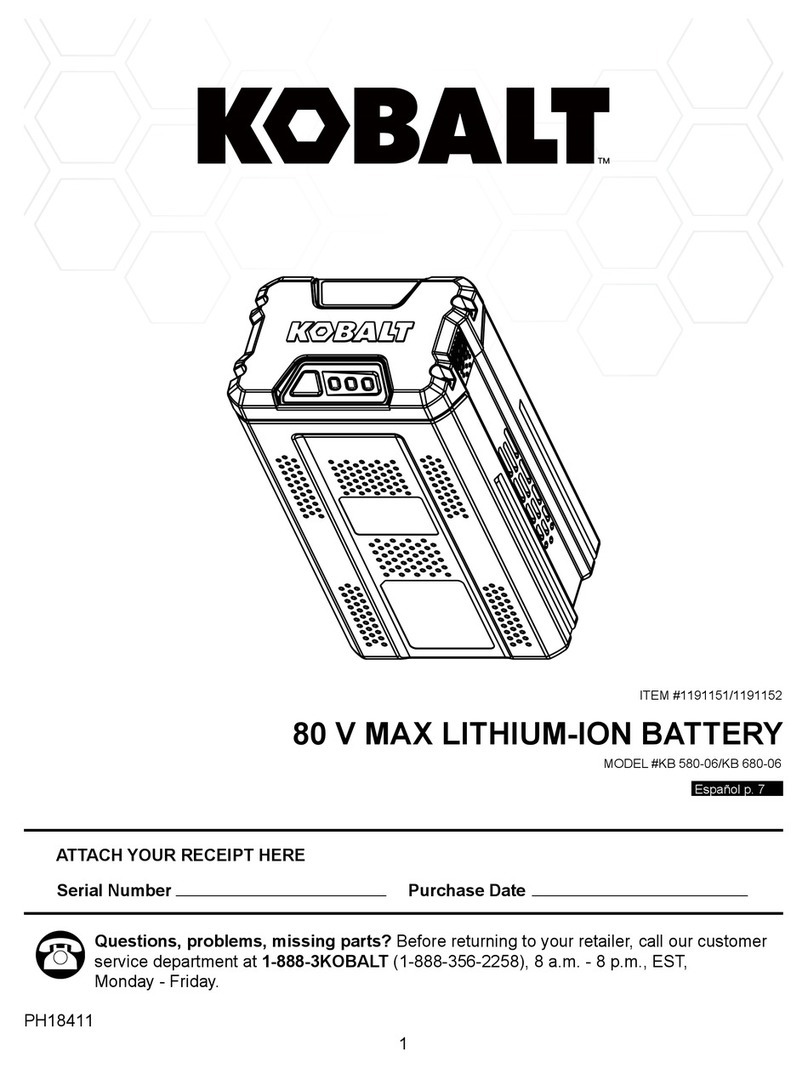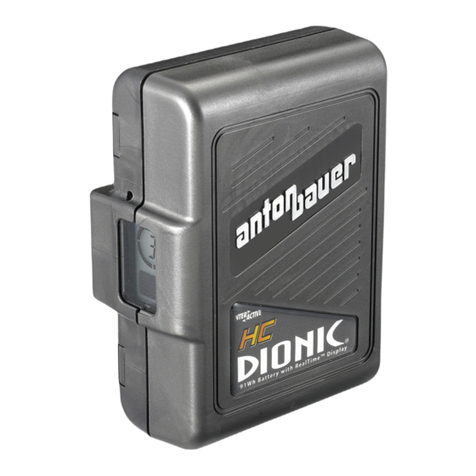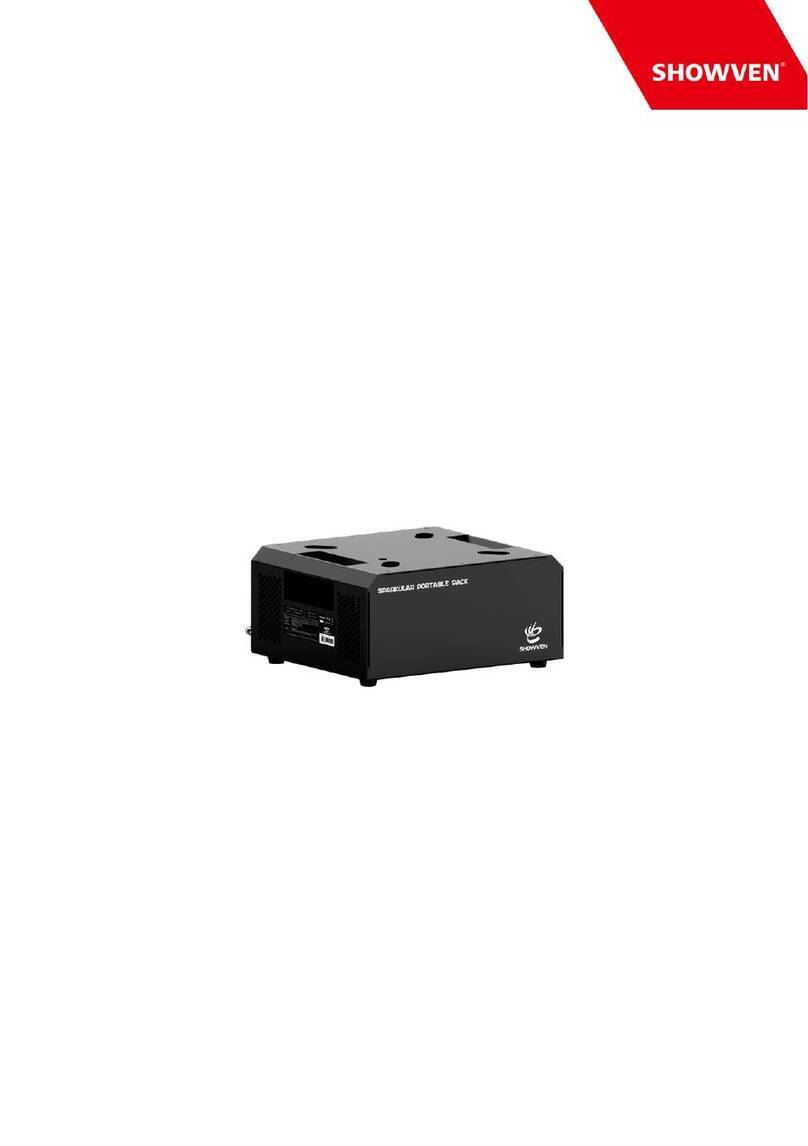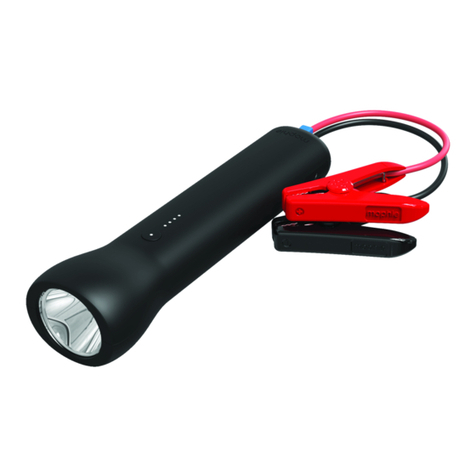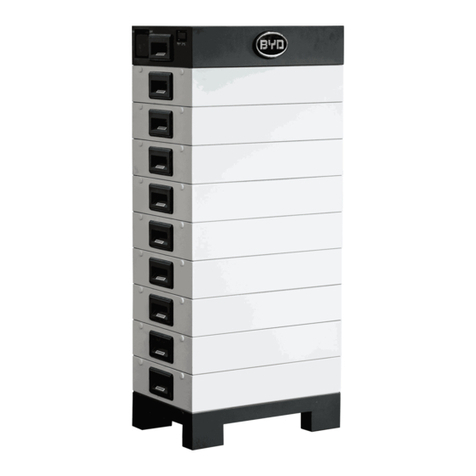Global Sources EV-CC48-450-I User manual

第 1 页 共 17 页
LiFePO4 Battery Pack Manual
Model:EV-CC48-450-I
EV-CC48-450-II
EV-CC38-600-I

第 2 页 共 17 页
LiaoNing Zlion Energy Co., Ltd.
Oct 30th,2020
Contents
1. Important safety instructions -------------------------------------------1
2. Enterprise introduction ---------------------------------------------------2
3. Battery pack index parameters ------------------------------------------3
4. Electrical schematic diagram of battery pack------------------------4
5. Operation and use of battery pack ------------------------------------5
6. Measures to deal with abnormal conditions -------------------------6
7. Battery maintenance --------------------------------------------------------7

第 3 页 共 17 页
I. Important safety instructions
In order to ensure safe and correct use, please read this instruction
manual carefully before use;
Ensure that batteries or battery packs are kept away from dangerous
goods or materials, such as corrosive chemicals, dangerous
mechanical equipment, high-temperature environments, etc.;
Unreasonable use of this series of products may cause smoke, such
as external short circuit, overcharging, and excessively high ambient
temperature. If smoke occurs, please cut off the power in time, use
carbon dioxide or dry powder fire extinguishers for disposal, and
bury them in sand or mud. Evacuate the crowd in time and call the
police in time (if necessary) during the whole process;
Unreasonable use of this series of products may cause swelling of the
single battery, and in severe cases, it may cause the plastic shell to
rupture or crack. At this time, you should stop using the battery
immediately. Please contact the relevant technical department or
after-sales service department of our company for treatment.
method;
It is forbidden to disassemble,squeeze,puncture,store or bake the
battery at high temperature to prevent the battery from being
subjected to excessive vibration,external force impact,falling from a

第 4 页 共 17 页
height,etc.This may cause personal injury or property damage;
It is forbidden to short-circuit the positive and negative poles of the
battery directly, and avoid any metal or other conductive objects
other than the battery pole compression bolts and the conductive
tape from contacting the positive and negative poles of the battery.
This operation may cause personal injury or property damage;
It is forbidden to expose or leave the battery in an environment
above 60℃for a long time, and it is forbidden to try to heat or throw
the battery into a fire. This operation may cause personal injury or
property damage;
It is forbidden to charge the battery without installing a reasonable
charging protection device (battery management system, etc.) or
using charging equipment (charger, DC power supply, etc.) not
approved by Zlion, this operation may cause personal injury or
property damage;
It is forbidden to immerse the battery in water or other conductive
liquids. This operation may cause personal injury or property
damage;
It is forbidden for children and others who lack the knowledge of the
safe use of lithium-ion batteries to use this series of products. This
operation may cause personal injury or property damage;
It is forbidden to use this series of products with other models or

第 5 页 共 17 页
types of batteries in series or parallel. This operation may cause
personal injury or property damage; it is forbidden to connect the
entire power system containing the lithium-ion battery management
system with other power systems in series or parallel Operation, this
operation may cause personal injury or property damage; in any case,
when testing or using the battery, the terminal voltage of the single
battery must be tested in real time to avoid overcharging or over
discharging the battery.
When the company stores for a long time, please charge the battery
with SOC to 80% and store it, and charge the battery once a month
(SOC to 80%).
II. Battery Pack Specification
2.1 Battery Pack Specification
No.
Function
Technical Specification
EV-CC48-450-I
EV-CC48-450-
II
EV-CC38-600-
I
Remark
1
Nominal
Voltage
51.2V
51.2V
38.4V
2
Voltage Range
40V-58.4V
40V-58.4V
30-43.8
Unit Voltage
2.5v-3.65v
3
Battery Style
LiFePO4
Unit Voltage
3.2v
4
Nominal
Capacity
450Ah
450Ah
600Ah
25℃,0.3C
5
Instruction
System
16 Parallel
16 Parallel
12 Parallel
6
Max. Capacity
22kwh
22kwh
22kwh

第 6 页 共 17 页
2.2 Charger Working Environment
No.
Performance
Application Environment
1
Altitude
≤3000m Full Load Output
2
Storage temperature
-40℃~+80℃
3
Working temperature
-20℃~55℃Normal Work; 55℃~75℃Derating Output
4
Relative humidity
0~95%
5
Installation
Environment
No severe vibration and shock
6
Dusty environment
No conductive or explosive dust, no gases or vapors that corrode
metals and damage insulation
2.3 Charger Specification
Performance
Specification
Remark
AHEVC45200C
AHEVC48200C
AC Input
7
Cont.Discharge
Current
250A
8
Max. Discharge
Current
400A
10S
9
Cont. Charge
Current
200A
10
Display
4.3inch Display
Display Battery
Working Status
11
SOC Estimation
Error
<10%
12
Charging
Heating
No
Yes
No
13
Charging
heating power
\
1200w
\
14
Charging
Temperature
5-45℃
-20-45℃
5-45℃
15
Discharging
Temperature
-20-55℃
-20-55℃
-20-55℃
16
Humidity (RH)
No More Than 90% Monthly
17
Working Place
Car
18
Installing Way
Floor Standing
19
IP Grade
IP54
20
Dimension(mm
)
820*740*420
820*740*420
975*410*650
L*W*H

第 7 页 共 17 页
Input Voltage
380VAC
L1+L2+L3+N+PE
Input Range
±15%
/
Input Wires
3 Phase 5 Wires
Working Frequency
50/60Hz
/
Effectiveness
≥93%
Rated Output
DC Output
Output Voltage
20-45V
30-60V
CAN Communication adjustable
Output Current
5-200A
10-200A
CAN Communication adjustable
Output Power
9kW
12kW
Max. Output Power
Auxiliary power output
voltage
12V
12V
±0.1V
Auxiliary Output Power
50W
50W
Max. Out Power
Stabilization Accuracy
≤1%
≤1%
/
Steady Flow Accuracy
≤1%
≤1%
/
Voltage Ripple (P-P)
≤1%
≤1%
/
HMI:
Display
4.3 inch LCD Screen
Display:Voltage, Current, Time,
SOC
Yellow indicator light
Power
The charger is energized normally
Green Indicator light
Charging
The charger has output
Red Indicator Light
Malfuntion
When the charger detects an error
Output cable, connector:
Output Connector
DIA320
Output cable length
3M
Output Cable Sq.
50
mm²
Communication
Communication Way
CAN
Communication with battery BMS
Protocol
CAN Tiecheng Charging
Agreement
/
Mechanical:
Dimension (mm)
400×346×800
500×331×1068
±2mm
Weight
53kg
60kg
±1kg
Others:
Working Noise
≤60dB
/
IP Grade
IP54
/
Cooling Way
Wind
/
2.4 Output Cable
Phase
Specification
Remark
L1
4mm²
Brown
L2
4mm²
Black
L3
4mm²
Blue

第 8 页 共 17 页
N
2.5mm²
Grey
Ground
2.5mm²
Two Color
III. Electrical Schematic Diagram
3.1 Battery Pack Electrical Schematic Diagram
Electrical schematic diagram of battery pack with heating function
Electrical schematic diagram of battery pack without heating function

第 9 页 共 17 页
3.2 Schematic Diagram of Charger Battery

第 10 页 共 17 页
IV. Battery Pack Operation
4.1 Battery Pack Output Port Function Description
4.2 Charger output port function description

第 11 页 共 17 页
4.3. Description of battery pack display
4. 3.1 First Page
Refers to the actual power soc of the battery pack. For example, the
battery is fully charged at 100% SOC, and the battery is in a dead state
at 0% SOC. Generally, when the SOC is lower than 20%, the battery
pack is charged in time.
Refers to the current when the battery pack is in use
Refers to the voltage of the battery pack in the current state
4.3.2 Second Page
Display the voltage and internal temperature status of each cell in the battery pack

第 12 页 共 17 页
4.4 Description of charger display
4.5 Battery pack operation
4.5.1 Connect the discharge port of the battery pack to the discharge
port of the forklift

第 13 页 共 17 页
Battery pack discharge plug (Anderson 350A)
4.5.2 Press the "switch" when discharging, the switch power light will
light up, and the battery pack will start;
4.5.3 After the battery pack is started, various information of the battery
pack will be displayed on the battery pack display screen, such as:
battery pack voltage, temperature, etc.;
4.5.4 Start the vehicle and observe whether the battery pack display
information has warning information;
4.5.5 At the end of use, turn off the "switch", the switch power light goes
out, and the battery pack is turned off;
4.5.6 When the battery pack is not in use, be sure to turn off the battery
pack "switch" in time;
4.5.7 When charging, just insert the charging plug.
4.5.8 Precautions when installing the battery pack:
•Install the battery pack with the battery pack closed;
•Please confirm whether the voltage model matches before installation, otherwise
the
battery pack may be damaged or a safety accident may occur;
•Before installation, confirm whether the positive and negative poles of the battery
pack are
correct. Short-circuiting of the positive and negative poles is prohibited.
Short-circuiting the positive and negative poles may cause safety accidents;
4.6 Charger charging operation

第 14 页 共 17 页
4. 6.1 Connect the charger to AC380V power supply as required;
4.6.2 Connect the DC output plug of the charger to the charging plug of
the battery pack; check whether the "positive and negative" are
correctly connected before the connection
Battery pack charging plug Charger charging plug
(REMA320A) (REMA320A)
4.6.3 After the charging plug is connected, turn on the "Charger AC input
air switch";
4.6.4 Turn on the "Start Switch";
4.6.5 The charger enters the charging state;
4.6.6 After charging is over, first turn off the "start switch"; then turn off
the "charger AC input air switch";
4.6.7 Pull out the charging plug again.
4.6.8 Precautions for charging:
•Turn off the battery pack "start switch" after charging;
•Please choose to charge in a relatively safe environment (such as avoiding liquids,
fire sources,etc.);
•Necessary safety fire extinguishing devices must be equipped around the charging
equipment so that emergency fire extinguishing can be carried out in extreme
cases;
•Before charging, make sure that there are no foreign objects such as dust, water, etc.
in the charging plug and charging socket. If there are foreign objects, they need to be

第 15 页 共 17 页
cleaned up before charging, otherwise it will cause poor contact between the
charging gun and the charging socket and cause heat or even fire;
•Do not modify or disassemble the charging port and charging equipment, which
may cause charging failure and cause a fire;
•After charging, do not disconnect the charging device with wet hands or standing in
water, as this may cause electric shock and personal injury;
•If you need to end the charging during the charging process, please turn off the
"start switch" first. When the current drops to 0A, the charging plug-in can be
disconnected, otherwise the on-load cut-off will cause damage to the relay and burn
the plug-in terminal.
•When the battery power is less than 20%, it should be recharged in time, and the
battery is strictly prohibited from over-discharge;
•The battery should be charged in time after use, especially in a low temperature
environment, and the charge should be fully charged;
•In order to avoid damage to the charging equipment, please pay attention to the
following items:
a) Do not pull or twist the charging cable;
b) Do not subject the charging equipment to impact;
c) Do not use the charging equipment in an environment with a temperature
higher
than 55°C;
d) It is forbidden to directly plug and unplug the charging plug-in when the
charging equipment has current output, which may cause electric
arcing,causing property damage and personal injury;
e) Do not place the charging equipment near heaters or other heat sources.
•Note that the items not mentioned above are mainly safety.
V. Measures to deal with abnormal conditions

第 16 页 共 17 页
If the battery pack has the following abnormal conditions,
immediately take the following measures and contact us.
A. If the battery pack starts to smoke or catch fire while in use, stop charging and
discharging immediately and leave quickly. The battery pack catches fire during
storage, use carbon dioxide or dry powder fire extinguishers for disposal, and bury
it in sand or mud. During the above process, the crowd must be evacuated in time
and report to the police in time (if necessary);
B. During use or storage, if the battery pack emits an unpleasant smell or abnormal
heat, deformation, etc., you should stop using it immediately and contact us.
Failure to do so may cause the battery to heat up, burst or catch fire.
C. If the battery pack leaks or emits an unpleasant smell, immediately keep it away
from the fire source, otherwise, the leaked liquid may cause fire or explosion
D. When the electrolyte leaked from the battery pack enters the eyes, do not rub
the eyelids, wash them off with clean water immediately and see an
ophthalmologist, otherwise it will cause damage to the eyes.
E. When the battery explosion-proof valve is ruptured, do not inhale the exhaust gas.
Excessive inhalation of the gas may cause poisoning and throat problems.
F. When the leaked electrolyte sticks to the skin or clothes, wash it off with water
immediately to avoid skin poisoning.
G. When using the battery pack, if the voltage of the single battery is lower than
2.5V or higher than 3.65V for a long time, you should stop using it immediately
and contact us in time.
H. When the battery pack is in use, when the management system continues to
alarm, stop using it immediately and contact us.
I. When the SOC of the battery pack drops below 20%, the battery pack should be
charged immediately.
VI. Battery Maintenance Operation
6.1 Maintenance site requirements: Spacious, flat, safe, and

第 17 页 共 17 页
charging equipment.
6.2 Maintenance operation process:
Step 1: Adjust the battery power to ensure the battery SOC between 25% and 40%.
Step 2: Stop the vehicle, turn off the power supply, and check all electrical
equipment in the vehicle to ensure that it is turned off.
Step 3: Disconnect the discharging connector and the charging connector.
6.3 Periodic inspection requirements:
Every three months of operation of the vehicle, a comprehensive inspection is
required. The specific inspection items are as follows:
•Whether the high and low voltage wiring harness of the battery system is damaged,
scratched, or loose.
•Whether the battery box is damaged.
•Whether the charging and discharging plug is damaged.
•Is the communication plug damaged?
6.4 Tips:
Before performing regular inspections, professionals must wear insulating shoes,
insulating gloves, goggles and other necessary protective equipment to ensure
personal safety.
This manual suits for next models
2
Popular Batteries Pack manuals by other brands

VonHaus
VonHaus 3500194 manual
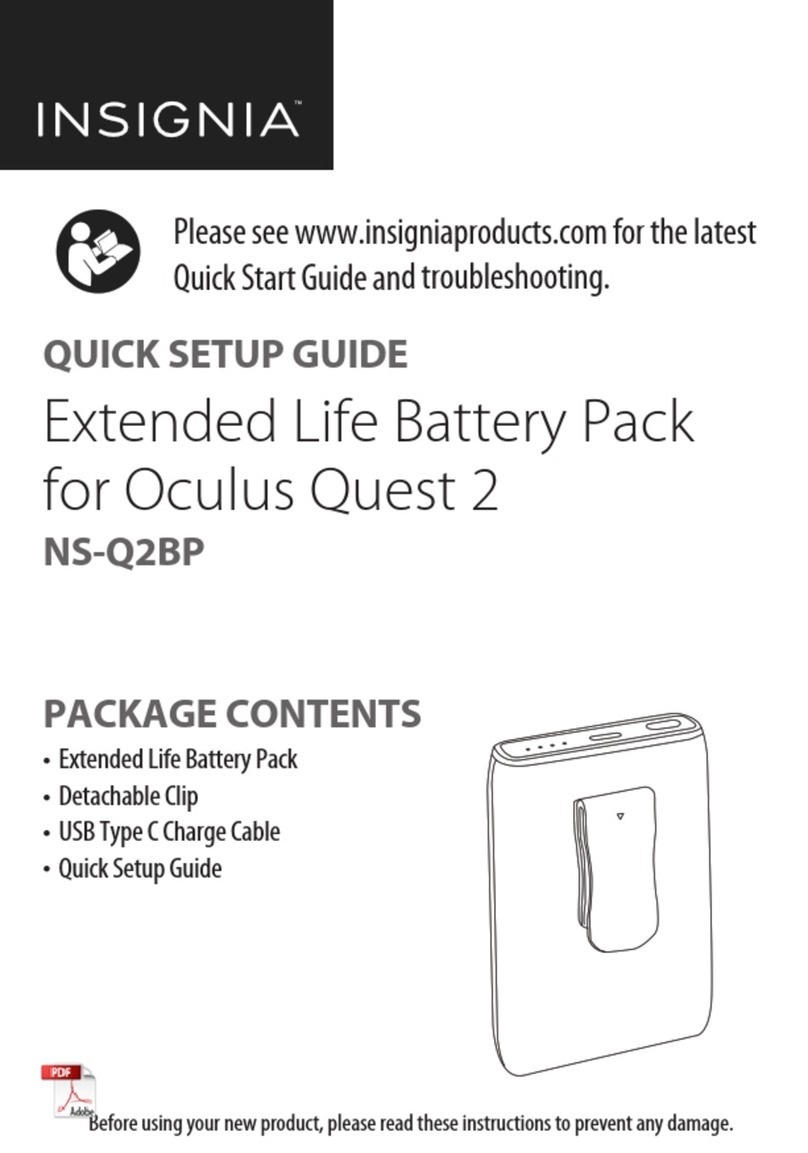
Insignia
Insignia NS-Q2BP Quick setup guide
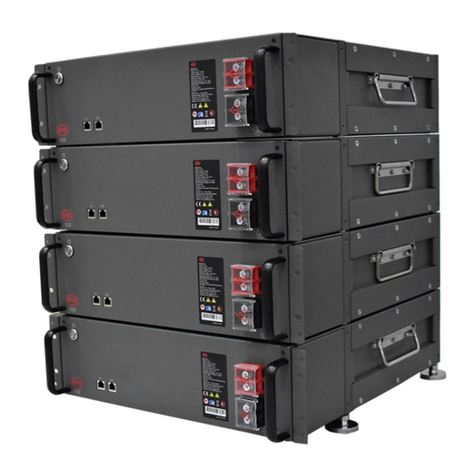
BYD
BYD Battery-Box LV Flex Lite operating manual
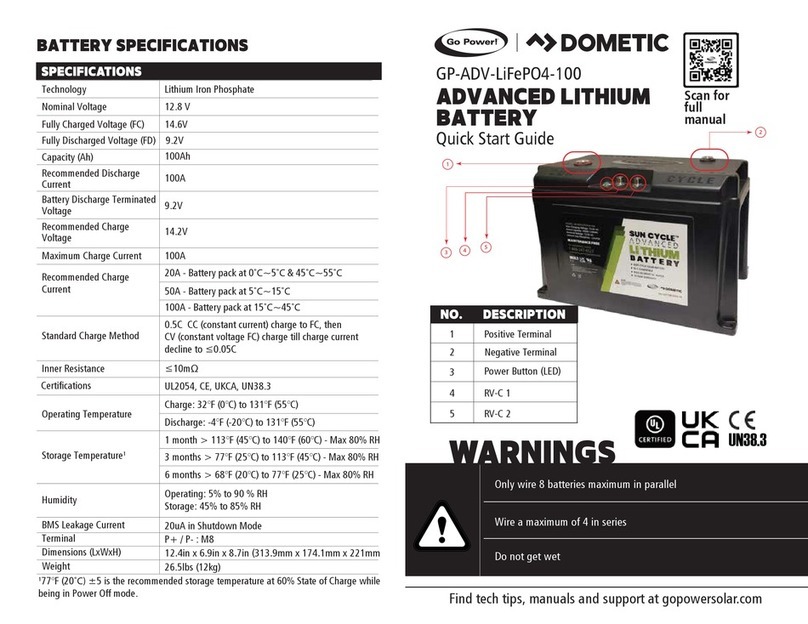
Dometic
Dometic Go Power! GP-ADV-LiFePO4-100 quick start guide
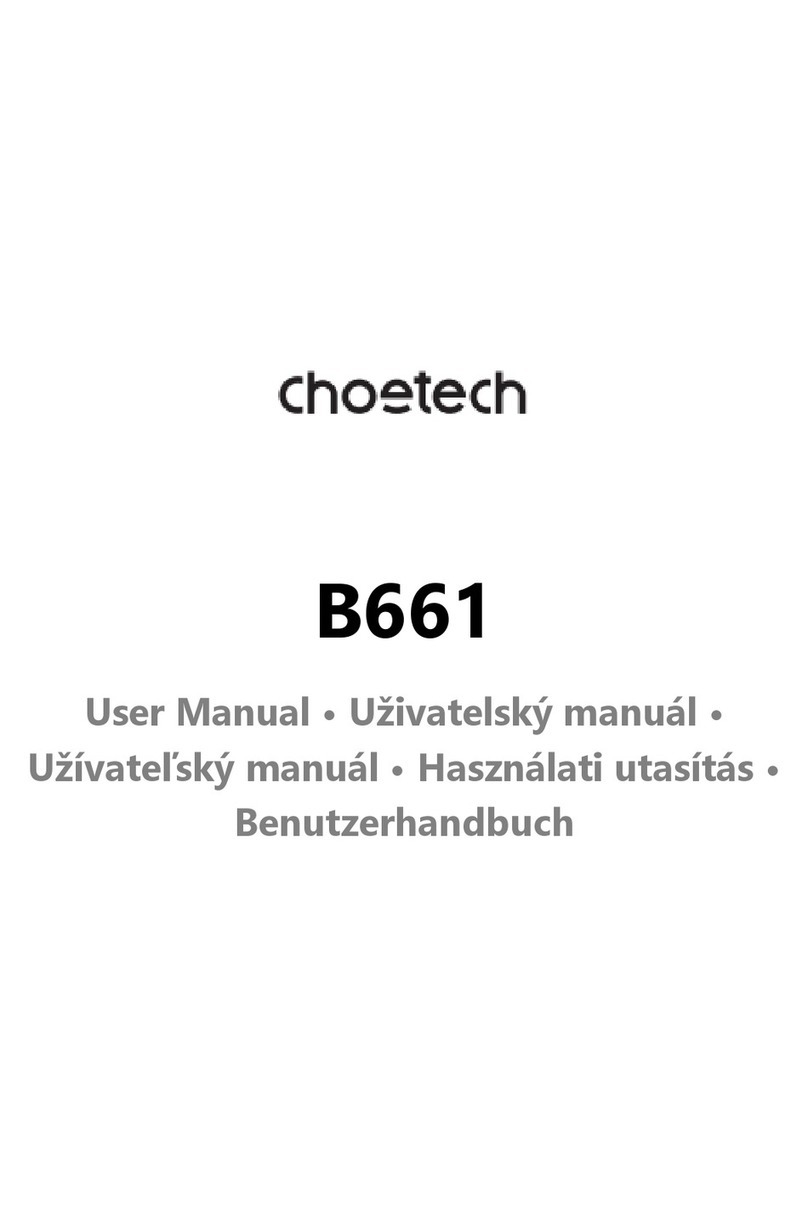
Choetech
Choetech B661 user manual
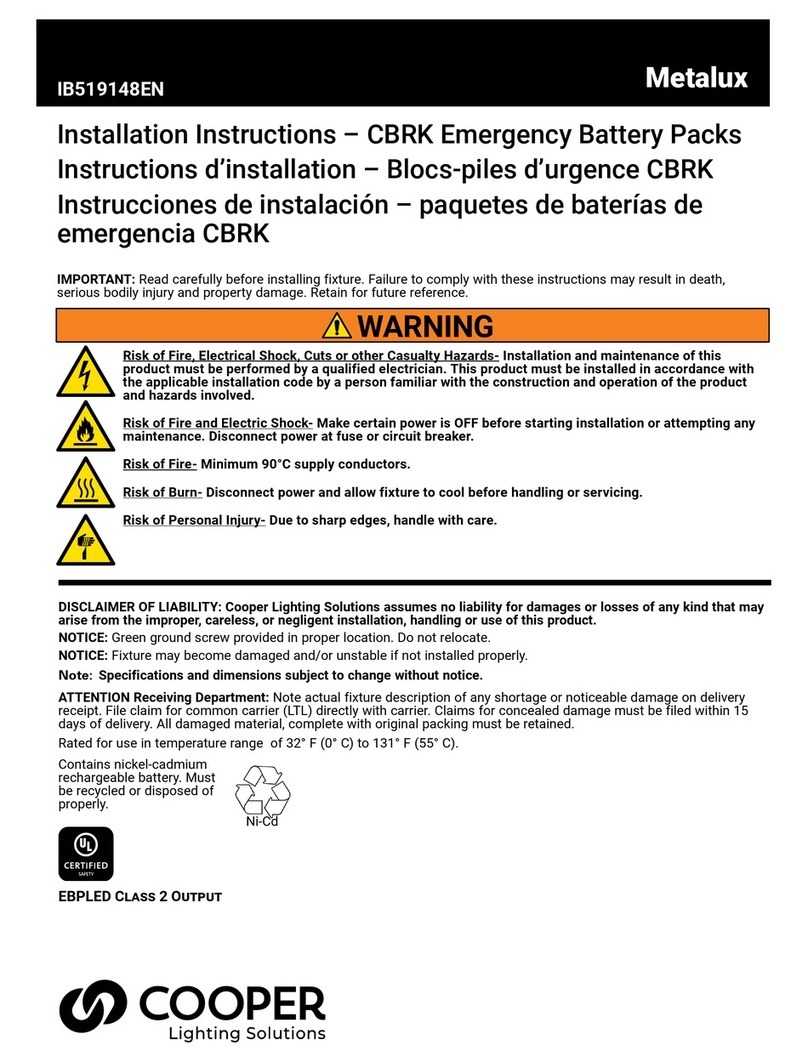
Cooper Lighting Solutions
Cooper Lighting Solutions Metalux CBRK installation instructions
